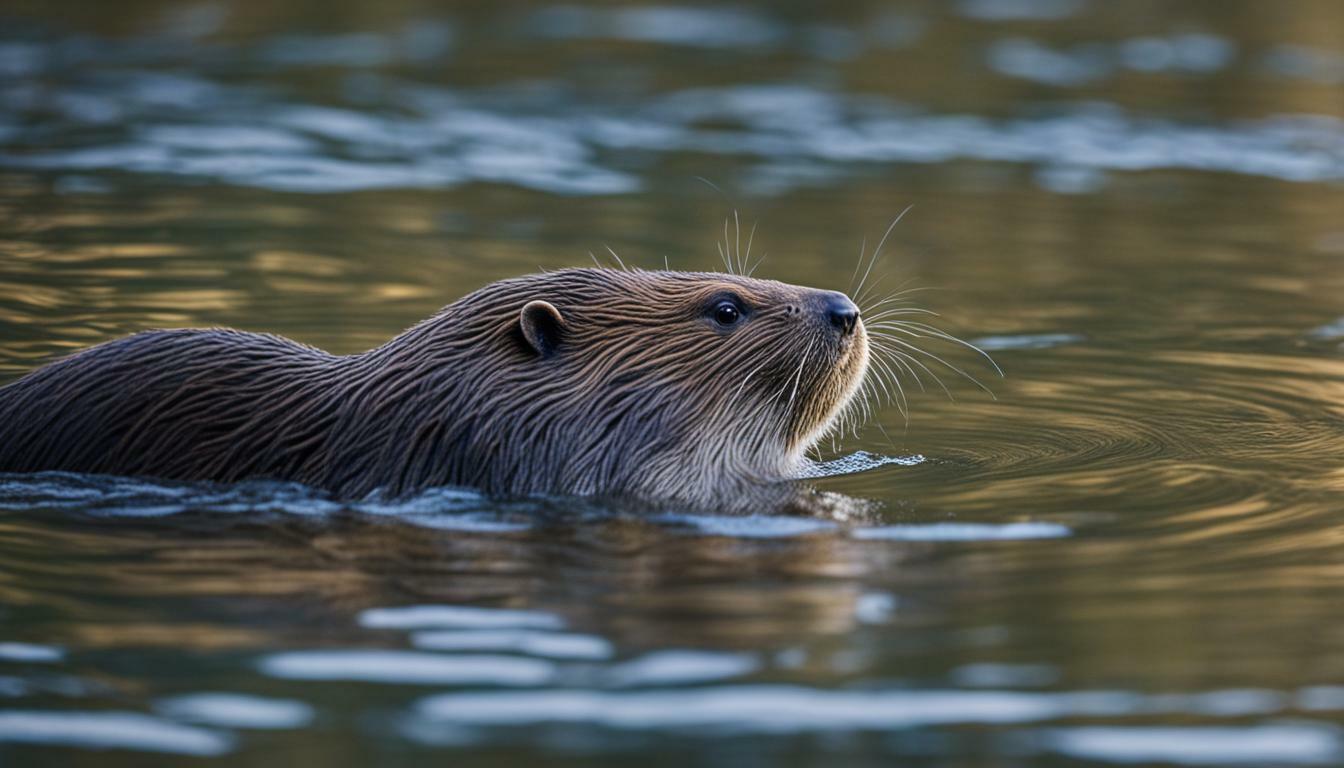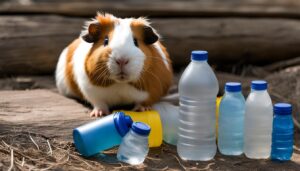Beavers are fascinating creatures known for their ability to spend extended periods of time underwater. Have you ever wondered just how long they can hold their breath? In this article, we will explore the incredible underwater behavior of beavers, including their breath-holding ability and the unique adaptations that enable them to thrive in aquatic environments.
Key Takeaways:
- Beavers can stay underwater for up to 15 minutes, while humans can typically hold their breath for only about 30 seconds to 2 minutes.
- Other diving mammals, like elephant seals, can hold their breath for even longer, up to two hours.
- Beavers and other diving mammals have developed physiological adaptations that allow them to slow their heart rate and concentrate blood flow around vital organs, enabling them to stay submerged for longer periods.
- They also have higher concentrations of myoglobin, a protein that binds with oxygen in their muscles, providing them with a larger supply of oxygen while underwater.
- Comparing beavers to other diving mammals reveals unique characteristics and abilities of each species.
Now, let’s dive deeper into the underwater behavior of beavers and discover how they can stay submerged for such impressive durations.
Beaver Underwater Behavior
When beavers dive underwater, they exhibit remarkable behaviors that allow them to thrive in their aquatic habitats. These behaviors include a unique diving technique and the ability to navigate effectively in underwater environments.
Beavers are known for their impressive diving technique, which involves a graceful descent into the water while minimizing disturbances on the surface. They use their large, webbed hind feet to propel themselves underwater, using powerful strokes that propel them forward with precision and agility.
Once submerged, beavers can hold their breath for an extended period due to their physiological adaptations. They close their nostrils and ears to prevent water from entering, and their transparent eyelids protect their eyes while allowing them to maintain some visibility underwater.
| Diving Techniques | Adaptations |
|---|---|
| Graceful descent into the water | Closing nostrils and ears |
| Powerful strokes with hind feet | Transparent eyelids for underwater visibility |
Underwater Navigation
Beavers have the ability to navigate effectively in underwater environments, thanks to their natural adaptations. They have a keen sense of direction and can use their strong and agile bodies to maneuver through obstacles such as fallen trees and submerged vegetation.
Their sharp incisors, which are well-suited for gnawing trees, can also be used to trim or remove underwater obstacles that may impede their movement. These remarkable behaviors and adaptations allow beavers to explore their underwater world and find the necessary resources to build and maintain their lodges and dams.
In summary, beavers exhibit remarkable behaviors when diving underwater, including a unique diving technique and effective navigation skills. Their physiological adaptations, such as closing their nostrils and ears and transparent eyelids, enable them to stay submerged for extended periods. These remarkable behaviors and adaptations contribute to their ability to thrive in their aquatic habitats.
Beaver Breath-Holding Ability
Beavers possess impressive breath-holding capabilities that far surpass those of humans. While humans can typically hold their breath for about 30 seconds to 2 minutes, beavers can stay underwater for as long as 15 minutes. This remarkable ability allows them to navigate their underwater habitat efficiently and carry out various tasks, such as building their dams and foraging for food.
So, how do beavers manage to hold their breath for such extended periods? One key factor is their ability to slow down their heart rate, which helps conserve oxygen. By reducing their heart rate, beavers can sustain their oxygen supply during prolonged dives. Additionally, beavers have the remarkable ability to change how blood flows in their bodies. They can shunt blood away from non-essential tissues and direct it towards vital organs, such as the brain and heart, where oxygen is needed the most.
Another important adaptation that enables beavers to stay submerged for longer durations is their higher concentration of myoglobin. Myoglobin is a protein found in muscles that binds with oxygen and serves as an oxygen storage reservoir. With higher levels of myoglobin, beavers have a larger supply of oxygen readily available in their muscles while underwater. This allows them to continuously receive oxygen and remain submerged for extended periods, supporting their activities in their aquatic environment.
| Mammal | Maximum Breath-holding Time |
|---|---|
| Humans | 30 seconds to 2 minutes |
| Beavers | Up to 15 minutes |
| Elephant Seals | Up to 2 hours |
Compared to other diving mammals, such as elephant seals, beavers may not hold their breath for as long, but their breath-holding ability is still quite impressive. By employing various adaptations, such as slowing their heart rate, redirecting blood flow, and having higher levels of myoglobin, beavers are able to thrive in their underwater habitat, staying submerged and accomplishing their tasks with remarkable efficiency.
Beaver Underwater Adaptations
Beavers have evolved a range of fascinating adaptations that allow them to excel in their underwater habitats. These adaptations enable them to stay submerged for extended periods, making them highly skilled aquatic mammals. Let’s explore some of the remarkable ways in which beavers have adapted to their underwater lifestyle.
One of the key adaptations that beavers possess is their specialized physical features. Their large, webbed hind feet act like paddles, providing efficient propulsion through the water. These webbed feet, coupled with their strong, flat tails, make beavers excellent swimmers, allowing them to navigate underwater environments with ease. Additionally, their dense fur acts as insulation, keeping them warm and buoyant in the water.
Beavers also possess physiological adaptations that contribute to their ability to stay underwater. One of the most notable adaptations is their higher concentration of myoglobin, a protein that binds with oxygen in their muscles. This allows beavers to store more oxygen and deliver it to their muscles while submerged. With a larger supply of oxygen, beavers can endure longer periods underwater, aiding in their foraging activities and dam-building efforts.
Table: Beaver Underwater Adaptations
| Adaptation | Description |
|---|---|
| Webbed Feet | Large, webbed hind feet provide efficient propulsion in water. |
| Flat Tail | Strong, flat tail aids in swimming and steering underwater. |
| Dense Fur | Insulating fur keeps beavers warm and buoyant in the water. |
| High Myoglobin Concentration | Increases oxygen storage and delivery to muscles while submerged. |
These adaptations collectively allow beavers to thrive in their aquatic environments. By efficiently utilizing their physical features and maximizing oxygen supply, beavers have become highly skilled divers, capable of staying underwater for as long as 15 minutes. Their ability to endure extended periods underwater is truly remarkable and sets them apart from many other mammals.
It is worth noting that while beavers excel in their underwater adaptations, other diving mammals like elephant seals possess their own unique set of adaptations. These adaptations may differ in various aspects such as breath-holding ability, diving depth, and oxygen storage capacity. Each species has evolved to suit its specific aquatic environment and lifestyle, showcasing the incredible diversity of adaptations found in the animal kingdom.
In summary, beavers have evolved remarkable underwater adaptations that enable them to thrive in their habitats. From their webbed feet and flat tails to their dense fur and high myoglobin concentration, these adaptations allow beavers to navigate underwater environments, stay submerged for extended periods, and excel in their underwater endeavors.
Maximum Time Beavers Can Stay Submerged
Beavers can stay submerged for an astonishing amount of time, surpassing the breath-holding abilities of many other mammals. These incredible creatures have the ability to hold their breath for as long as 15 minutes, which is significantly longer than the average human’s breath-holding capacity of about 30 seconds to 2 minutes. This impressive feat is made possible by a combination of behavioral and physiological adaptations.
When beavers dive underwater, they slow their heart rate and alter the flow of blood in their bodies. These changes help to conserve oxygen and redirect it to the vital organs, allowing them to stay submerged for extended periods. Additionally, beavers and other diving mammals have higher concentrations of a protein called myoglobin in their muscles. Myoglobin binds with oxygen, enabling beavers to have a larger supply of oxygen available while underwater.
It’s important to note that while beavers can stay underwater for a remarkable amount of time, there are other aquatic mammals that can hold their breath for even longer. For example, elephant seals have been known to hold their breath for up to two hours, making them the true champions of breath-holding among mammals. Nevertheless, the beaver’s ability to stay submerged for up to 15 minutes is still quite impressive in comparison to many land-dwelling animals.
| Mammal | Maximum Time Underwater |
|---|---|
| Beaver | Up to 15 minutes |
| Human | About 30 seconds to 2 minutes |
| Elephant Seal | Up to 2 hours |
Overall, the maximum time that beavers can stay submerged highlights the remarkable adaptations they have developed to thrive in aquatic environments. Their ability to slow their heart rate, redirect blood flow, and utilize myoglobin for oxygen supply enables them to navigate underwater with ease and spend significant amounts of time submerged. These adaptations contribute to the beaver’s overall success as a semi-aquatic mammal.
Comparing Beavers to Other Diving Mammals
While beavers have incredible underwater abilities, they are not the only mammals with remarkable diving skills. Other aquatic creatures, such as elephant seals, also possess impressive capabilities when it comes to staying submerged.
Elephant Seals
Elephant seals are known for their exceptional diving ability. These massive marine mammals can hold their breath for up to two hours, making them some of the longest-diving creatures on Earth. With their sleek bodies and efficient diving technique, elephant seals can reach incredible depths in search of prey.
One of the key factors that enables elephant seals to stay underwater for such extended periods is their ability to slow down their heart rate. By reducing their heart rate significantly, they can conserve oxygen and extend their time underwater. Furthermore, they have the unique ability to redirect blood flow away from non-essential organs, ensuring that vital organs receive an adequate oxygen supply.
Myoglobin: The Oxygen Storage
Both beavers and elephant seals possess higher concentrations of myoglobin, a protein that binds with oxygen in their muscles. This increased presence of myoglobin allows these mammals to store more oxygen and have a larger supply while underwater. The efficient utilization of myoglobin contributes to their extended breath-holding abilities and enables them to stay submerged for longer periods of time.
Although beavers may not hold the record for the longest dive among mammals, their underwater skills are undoubtedly impressive. Through various adaptations and physiological changes, these creatures can stay submerged for up to 15 minutes, surpassing the breath-holding capabilities of humans by a significant margin. Their remarkable abilities in the water make them truly fascinating animals that have successfully adapted to their aquatic environments.
| Mammal | Maximum Breath-Holding Time |
|---|---|
| Beavers | Up to 15 minutes |
| Elephant Seals | Up to 2 hours |
In conclusion, while beavers demonstrate impressive underwater abilities, there are other diving mammals like elephant seals that surpass them in terms of breath-holding. This comparison highlights the diverse range of adaptations and capabilities that different species have developed to thrive in their respective aquatic environments.
Factors Enabling Extended Underwater Stay
Several key factors contribute to the beaver’s impressive capacity to remain submerged for extended periods of time. These adaptations and behaviors allow them to navigate their aquatic environment with ease and efficiency.
Firstly, beavers have the ability to slow down their heart rate while underwater. By doing so, they conserve oxygen and can prolong their time spent submerged. This physiological adaptation is crucial for their survival, as it enables them to stay underwater for up to 15 minutes.
In addition to heart rate regulation, beavers also have the ability to redirect blood flow within their bodies. They can shift blood away from non-essential organs and towards their vital organs, such as the brain and heart. This redirection ensures that oxygen-rich blood is concentrated where it is most needed, further enhancing their breath-holding ability.
Another significant factor enabling beavers to stay underwater for extended periods is their high concentration of myoglobin. This protein binds with oxygen in the muscles, allowing beavers to store and utilize a larger supply of oxygen while underwater. The myoglobin acts as a reservoir, providing beavers with the necessary oxygen to sustain their physiological functions during prolonged submersion.
| Beaver Underwater Adaptations |
|---|
| Slowing heart rate |
| Redirecting blood flow |
| High concentration of myoglobin |
Overall, these adaptations and behaviors, including heart rate regulation, blood flow redirection, and high myoglobin concentration, allow beavers to excel in their underwater endeavors. Their remarkable ability to stay submerged for extended periods showcases the incredible adaptability and resilience of these fascinating aquatic mammals.
Beaver Myoglobin and Oxygen Supply
Beavers possess a higher concentration of myoglobin, a crucial protein that facilitates their oxygen supply while underwater. Myoglobin is responsible for binding with oxygen in the muscles, allowing beavers to have a larger reserve of oxygen during their dives. This adaptation is vital for their extended periods underwater, as it allows them to maintain a steady influx of oxygen and sustain their activities.
Myoglobin serves as an oxygen reservoir, releasing oxygen to the muscles when the beaver is submerged. This ensures that the beaver’s muscles receive the required oxygen to function efficiently, even in low oxygen conditions. The higher concentration of myoglobin in beavers, compared to other mammals, is one of the factors that enable them to stay underwater for such impressive durations.
By having a greater supply of oxygen, beavers can perform various activities while submerged. They can swim, search for food, build dams, repair their lodges, and carry out other essential tasks without the need to resurface frequently. This adaptation allows them to thrive in their aquatic habitats and effectively utilize the resources available to them.
| Species | Maximum Underwater Time |
|---|---|
| Beaver | Up to 15 minutes |
| Human | 30 seconds to 2 minutes |
| Elephant Seal | Up to 2 hours |
In conclusion, beavers possess remarkable underwater adaptations, including a higher concentration of myoglobin, which enables them to stay submerged for extended periods. Their ability to regulate their heart rate and redirect blood flow to vital organs further enhances their diving capabilities. These adaptations highlight the incredible survival strategies developed by beavers to thrive in their aquatic environments.
Conclusion
In conclusion, beavers are exceptional divers, capable of staying underwater for impressive lengths of time, thanks to their unique adaptations and physiological abilities.
While humans can typically hold their breath for only about 30 seconds to 2 minutes, beavers can stay submerged for as long as 15 minutes. This remarkable breath-holding ability is also seen in other aquatic mammals like elephant seals, which can hold their breath for up to two hours.
So, what allows these mammals to stay underwater for such extended periods? One key factor is their ability to slow down their heart rate and redirect blood flow to vital organs, ensuring a steady supply of oxygen. Additionally, beavers and other diving mammals have higher concentrations of myoglobin, a protein that binds with oxygen in their muscles. This elevated level of myoglobin enables them to have a larger supply of oxygen while underwater, further enhancing their ability to stay submerged.
With their impressive underwater capabilities, beavers showcase the remarkable adaptations and physiological mechanisms at play in the animal kingdom. These adaptations enable them to thrive in their aquatic habitats and carry out tasks such as building complex dams and lodges. Truly, beavers are remarkable creatures that exemplify the wonders of nature.
FAQ
How long can beavers stay underwater?
Beavers can stay underwater for as long as 15 minutes.
How does beaver underwater behavior differ from other mammals?
Beavers have developed a unique diving technique and the ability to navigate underwater environments.
What is the breath-holding ability of beavers?
Beavers can hold their breath for extended periods, thanks to physiological factors that allow them to do so.
What adaptations do beavers have for underwater living?
Beavers have specific physical features and physiological changes that enable them to thrive in aquatic environments.
What is the maximum time beavers can stay submerged?
Beavers can stay underwater for up to 15 minutes, which is longer than most other mammals.
How do beavers compare to other diving mammals?
Beavers have unique underwater abilities, but some other mammals like elephant seals can hold their breath for even longer periods.
What factors enable beavers to stay underwater for extended periods?
Beavers regulate their heart rate and have increased levels of myoglobin, which aids in oxygen supply to vital organs.
How does beaver myoglobin contribute to their underwater abilities?
Beavers’ higher concentrations of myoglobin allow them to have a larger supply of oxygen while underwater, aiding in their extended dive times.
How long can humans typically hold their breath compared to beavers?
Humans can typically hold their breath for only about 30 seconds to 2 minutes, whereas beavers can stay submerged for up to 15 minutes.




